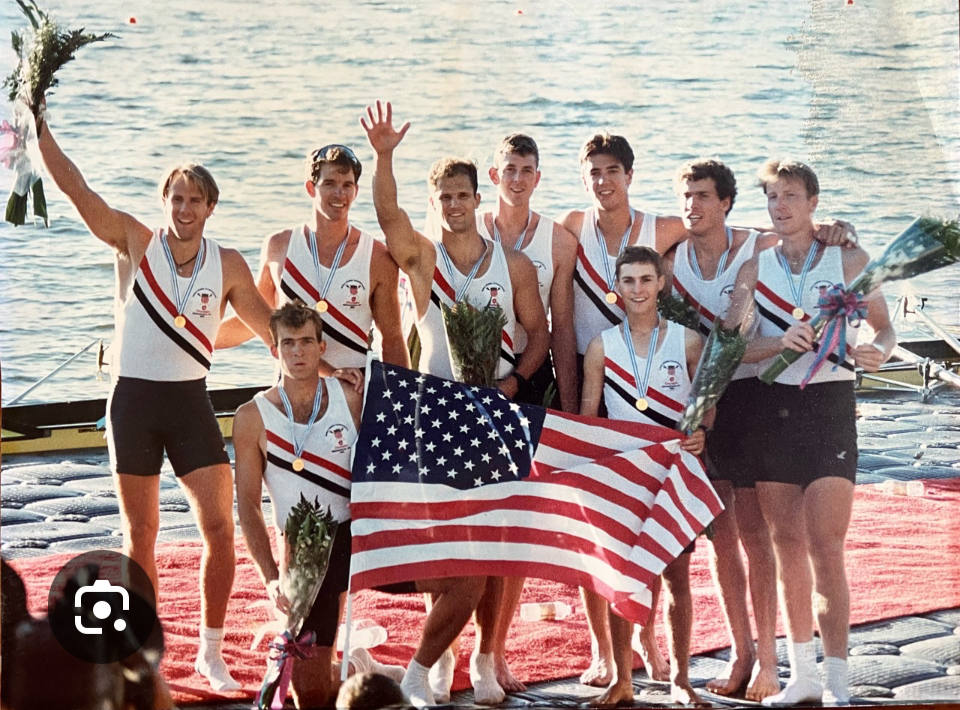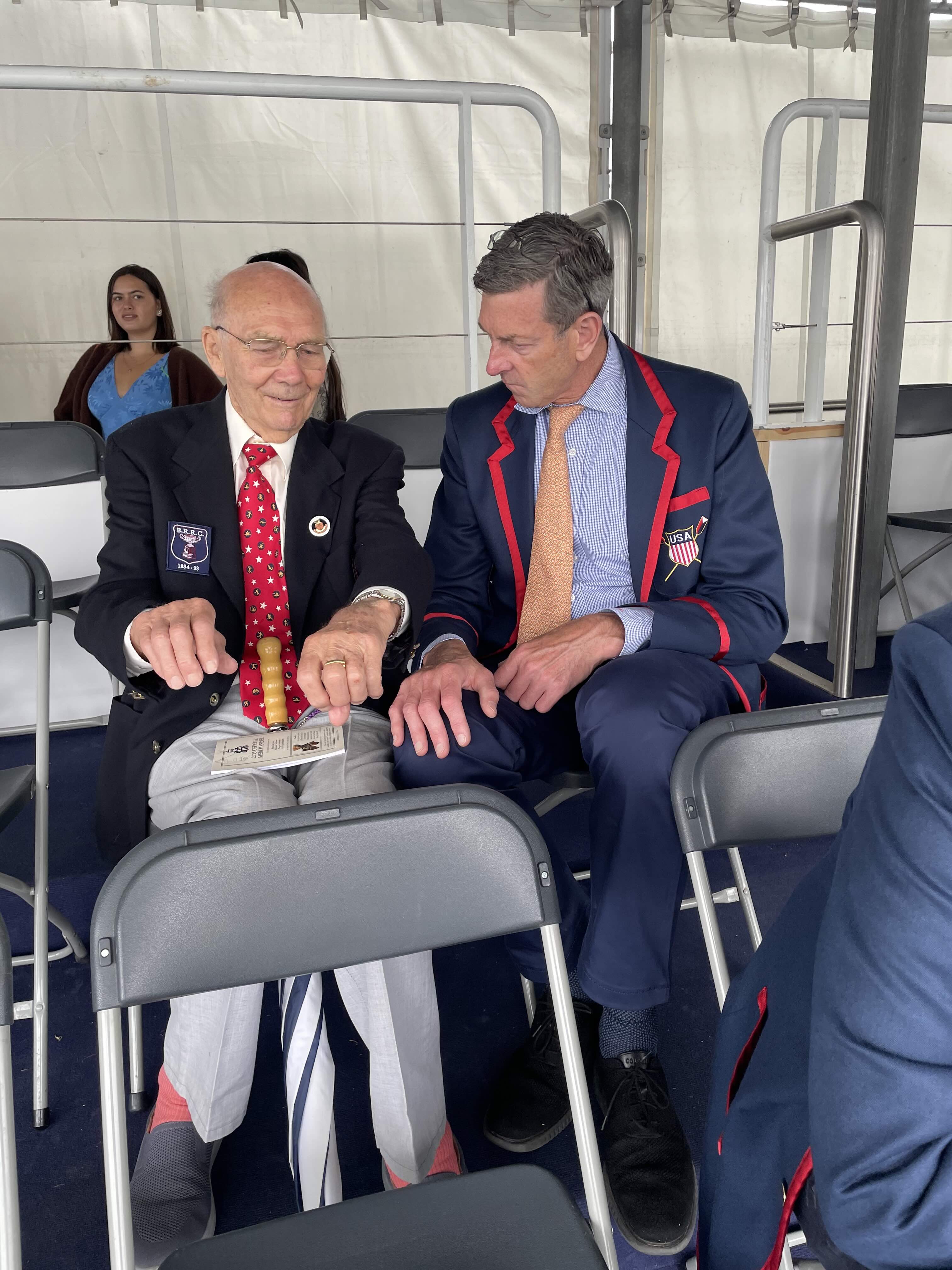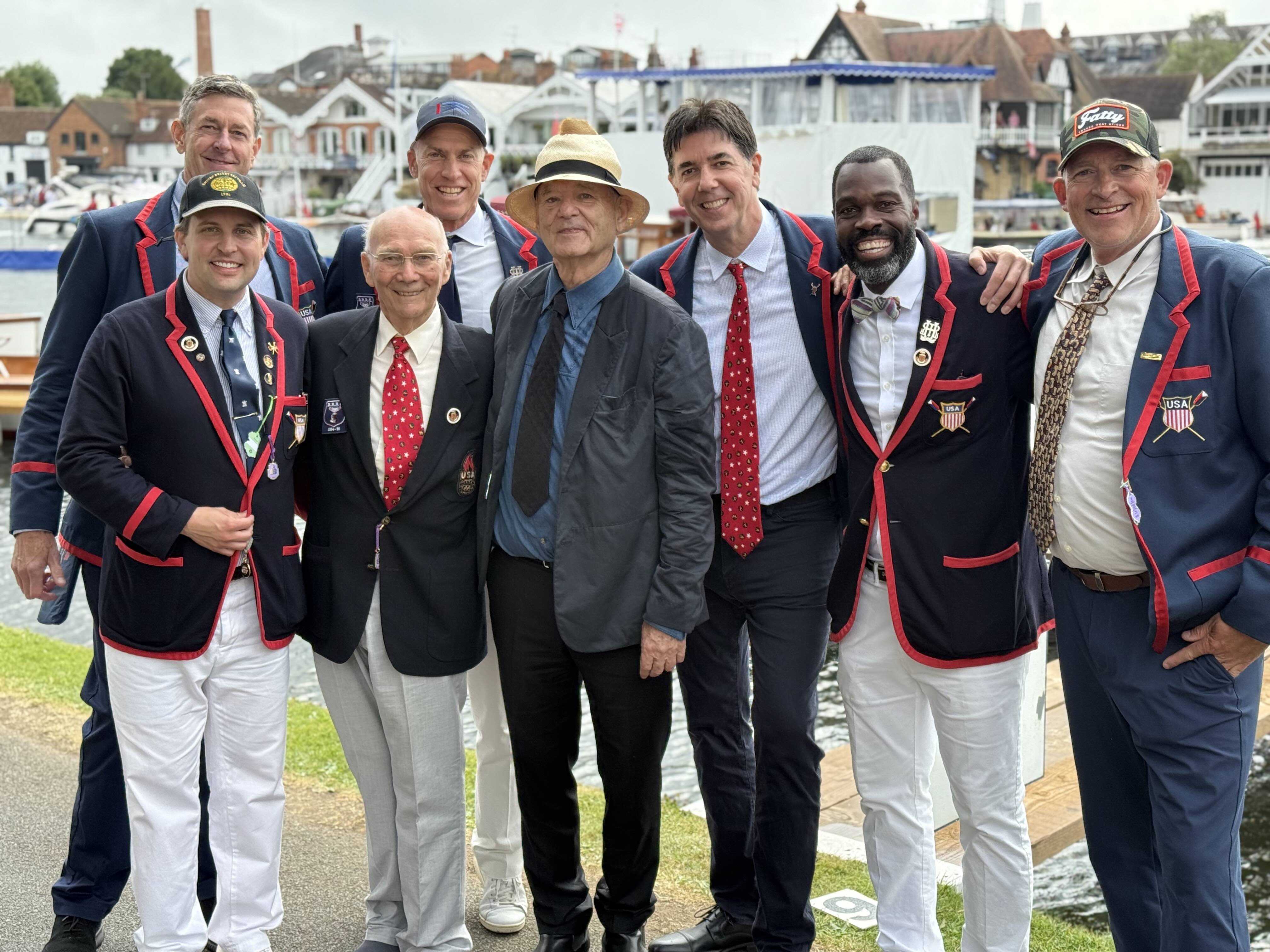Sometimes we’re so busy doing the work to get there that we don’t realize we’ve arrived. It can take the most surreal moment, in the most surreal setting, to see where we fit in the fabric of history — and to appreciate that our own accomplishments, though maybe not as grand as those we admire, stand on their own.
This year at Henley Royal Regatta, I had that experience. I was sitting at a table on a floating dock in front of Leander Club, sipping sparkling wine. At the table with me were Steven Segaloff, Jon Brown, Mike Peterson, Chip McKibben, the dynamic duo of Fred Honebein and Don Smith, Jamie Koven, Tim Ryan — and the legendary coach Mike Spracklen.
 From left to right: Jamie Koven, Chip McKibbon, Fred Honebien, Don Smith, Aquil Abdullah, Mike Peterson, Jon Brown, Mike Spraklen, Steven Segaloff
From left to right: Jamie Koven, Chip McKibbon, Fred Honebien, Don Smith, Aquil Abdullah, Mike Peterson, Jon Brown, Mike Spraklen, Steven Segaloff
Now, as elite athletes — or more correctly, former elite athletes — we don’t often fanboy around each other. Ours is a world of jokes and barbs, rooted in the limitless trust required to execute as a team at the highest level of sport.
As I sat there listening to them recount stories of life at the Olympic Training Center in Chula Vista, escapades in the streets of Indianapolis after winning the 1994 Rowing World Championships, and their Grand Challenge Cup victories at Henley in 1994 and 1995, it was almost as if I had been there — and at times, it felt as though they somehow remembered the stories with me in them.
And then it happened. We started talking about the 1994 Rowing World Championships, and I was transported back to a time when they were legends — and I was just an unknown rower at The George Washington University with big dreams.
 GWU Crew in Japan. From left to Right: Alex Mundt, Aquil Abdullah, Dave Kryzwda, Matt Russell, John Devlin, Tony Spinelli, Scott McDonald,Tim Downs, Jon Otto. Front: Coxswain Caroline Prior
GWU Crew in Japan. From left to Right: Alex Mundt, Aquil Abdullah, Dave Kryzwda, Matt Russell, John Devlin, Tony Spinelli, Scott McDonald,Tim Downs, Jon Otto. Front: Coxswain Caroline Prior
On September 17, 1994, after a grueling practice on the Potomac River, my coach John Devlin told the team we were welcome to go watch the finals of the World Championships in Indianapolis — as long as we were back for practice on Monday. Both the U.S. men’s and women’s eights had made the A Finals. They would be racing for world titles the next day.
I’d only started rowing a few years earlier. Unlike American football, baseball, basketball, or hockey, it was rare to see the best athletes in my new sport up close. Being new to the sport, I devoured any rowing lore I could find — I read The Amateurs by David Halberstam, Assault on Lake Casitas by Brad Lewis, and every issue of USRowing magazine cover to cover. But this was different. This time, I was going to see history made. I was going to be there, in person.
I can’t remember how many cars we took or everyone who made the drive, I just remember Matt Russell, Perky Gogo, Dave K., and myself piling into a car with no tickets, no place to stay, and the excitement of a gang of kids on Christmas Eve. Matt recalls me falling asleep and making him drive the whole way, but whoever drove, it was through the night. We arrived at Eagle Creek early Sunday morning. The combination of no sleep, at least for Matt, caffeine, and pure adrenaline put me in prime fanboy form.
Security back then wasn’t what it is now, and as a fledgling sculler I wandered around trying to find the single scullers. I saw Giovanni Calabrese, André Willms, Itzok Čop, Václav Chalupa Jr., and of course future Olympic champion and Brown Rowing juggernaut Xeno Müller. I didn’t know it then, but I was looking at my future — because at some point, I’d be on the starting line looking across at Chalupa and Čop. But in 1994, I was just a new rower, awestruck by the greats.
The rest of the day was a blur. After the U.S. women’s eight took silver, the stage was set for the race we’d driven ten hours to see. The Ukrainians jumped the start and disqualified themselves, leaving a five-boat final. The next start was clean. The U.S. got out to a blazing fast start, rating a 42 through the first 750 meters. At the 1,000-meter mark, they were in the lead — and the only question was whether they could hold on.
I don’t know what calls Steven Segaloff made that day, but he pulled every ounce of speed out of Jeff Klepacki, Jamie Koven, Jon Brown, Don Smith, Bob Kaehler, Chip McKibben, Fred Honebein, and Sean Hall. With the Dutch closing fast in the final meters, the U.S. held on to win gold at home.
 1994 World Champion Men's Eight, Team USA
1994 World Champion Men's Eight, Team USA
Fred’s laugh pulled me out of my reverie on that floating dock at Henley. In that moment, I realized I had rowing stories of my own — many of them connected to the men at that table. Mike Spracklen had already left the U.S. by the time I scraped my way onto the national team and then the 2004 Olympic team, but the men he coached carried his legacy with them.
It was then that I understood: I may not have won as many medals as I’d hoped, or raced in as many Olympics as I’d dreamed — but the very fact that I was sitting there with them meant I’d accomplished something worthwhile.



I never got the chance to watch the U.S. men’s eight win the Grand Challenge Cup in ‘94 and ‘95, and I never got to train with Chip McKibben or Mike Peterson. However, I did have the opportunity to train with Jon Brown and race against Jamie Koven and Don Smith. But whether it was chatting with legendary actor Bill Murray or doing the robot in a club after dinner, the strength of the bond we shared as we talked about the days of yore was rooted in the fact that we had all gone through the crucible and were all better because of it.
 1995 Grand Challenge Cup Winners at Henley Royal Regatta
1995 Grand Challenge Cup Winners at Henley Royal Regatta
I doubt these men have any idea how inspiring they were to me—the ones who attended the 2025 Henley Royal Regatta and the ones who were part of the US National Team from 1993-1996 but could not attend the regatta. We are friends now. I no longer place them on a pedestal, but in those rare moments when the sparkling wine hits just right, I might be reminded of my fanboy days.
On Sunday, between finals, I met with a young man named Justin Hurlock, who wants to race at Henley Royal Regatta one day. I gave him all the advice I could. Sitting here now, writing down my thoughts, I am reminded of the younger version of me who wandered around the athlete’s area in Indianapolis, hoping to catch a glimpse of some rowing legends. I am reminded of the first time I put on my kit to race as a member of the US National Rowing Team, and I am reminded of the moment when I realized I was stepping into my own legacy.


I wonder if someday I’ll have the pleasure of sitting down with Justin as he reflects on his own accomplishments, and if in that moment, he’ll realize what I realized at Henley—that he too has arrived.



